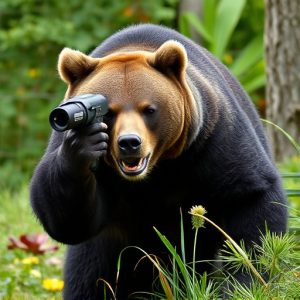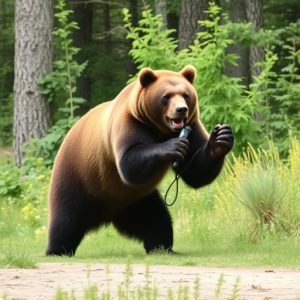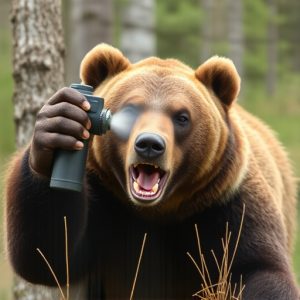Bear Spray Fog Pattern Test: Effectiveness & Safety Tips
The Bear Spray Fog Pattern Test is a critical evaluation method assessing the effectiveness of bear…….
The Bear Spray Fog Pattern Test is a critical evaluation method assessing the effectiveness of bear spray in real-life scenarios, simulating close encounters with aggressive bears. This test measures range, coverage, and density of the spray's fog pattern, providing insights into performance. By replicating charging bear conditions, experts determine optimal usage strategies, enhancing safety during bear interactions in natural habitats. The test considers factors like range, duration, weather, terrain, and bear behavior, enabling users to make informed decisions and prioritize safety through proper deployment techniques and complementary tactics like noise-making and traveling in groups. Regular testing ensures bear spray remains effective, emphasizing the importance of maintenance for emergency preparedness.
Bear encounters can be dangerous, but understanding bear spray effectiveness is key to staying safe in grizzly territories. This comprehensive guide explores the science behind bear spray, focusing on the crucial Bear Spray Fog Pattern Test. We’ll delve into factors influencing its potency and offer insights on effective use and safety precautions. Additionally, discover alternative measures for enhancing bear safety beyond spray.
- Understanding Bear Spray Fog Pattern Test
- Factors Affecting Bear Spray Effectiveness
- Effective Use and Safety Precautions
- Alternative Measures for Bear Safety
Understanding Bear Spray Fog Pattern Test
Understanding Bear Spray Fog Pattern Test
The Bear Spray Fog Pattern Test is a crucial evaluation method that assesses how effectively bear spray disperses and creates a protective barrier against charging bears. This test simulates real-life scenarios where individuals might need to defend themselves in close proximity to an aggressive bear. By analyzing the fog pattern, experts can gauge the range, coverage, and density of the spray, providing critical insights into its performance.
This test involves releasing bear spray into a controlled environment, often mimicking the distance and speed of a charging bear. Observers then measure the spray’s reach and visibility, ensuring it creates a substantial barrier that disrupts the bear’s ability to make contact with the user. The Bear Spray Fog Pattern Test is an indispensable tool in determining the optimal usage strategies for bear spray, ultimately enhancing safety measures when encountering these majestic yet potentially dangerous animals in their natural habitats.
Factors Affecting Bear Spray Effectiveness
The effectiveness of bear spray depends on several factors, including the fog pattern it creates and how closely it mimics natural environments. One key aspect is the spray’s range and duration. Bear spray should ideally create a dense fog that lingers, allowing for a longer period to disrupt and deter an approaching bear. The Bear Spray Fog Pattern Test helps evaluate these properties by simulating real-world scenarios.
Additionally, factors like weather conditions, terrain, and the bear’s behavior play significant roles. Wind direction can affect how the spray dissipates, while rough terrain might disrupt the fog’s reach. Understanding these variables is crucial for users to make informed decisions during encounters.
Effective Use and Safety Precautions
Effective Use and Safety Precautions
Bear spray is most effective when used in a specific way, known as the “fog pattern test.” This involves spraying the can horizontally at close range, creating a dense cloud of aerosol. The fog pattern should fill the bear’s face and eyes, temporarily blinding and disorienting it. Aim for the bear’s face and eyes to maximize impact, ensuring you stay well clear of any mist that might drift towards you.
Safety precautions are paramount when carrying bear spray. Always keep the can in an accessible location, like a belt pouch or pack, so it’s ready for quick deployment. Familiarize yourself with the spray’s range, pull-pin mechanism, and wind conditions before heading into potential bear country. Never turn your back on a bear, and if a charge occurs, use the spray as directed while retreating slowly. Regularly test and maintain your bear spray to ensure it remains effective and functional when needed.
Alternative Measures for Bear Safety
While bear spray is widely recognized as an effective deterrent against charging bears, it’s not the only measure for staying safe in bear country. Understanding the science behind bear behavior and utilizing alternative strategies can further enhance safety. One such method involves observing the bear’s fog pattern during a potential encounter. The Bear Spray Fog Pattern Test helps determine the spray’s reach and effectiveness by tracking the dispersal of the aerosol mist, ensuring users employ the product optimally.
Additionally, knowing the right time to deploy bear spray—when a bear enters your space or shows aggressive signs rather than just being curious—can make all the difference. Other alternative measures include making noise while hiking (to deter bears from ambushing) and traveling in groups for added visibility and protection. These complementary strategies empower individuals to navigate bear country with enhanced awareness and preparedness.
Bear spray, when used correctly, can be an effective deterrent against aggressive bears. Understanding the fog pattern test ensures you select a product with optimal range and coverage. Several factors, including wind, terrain, and bear behavior, influence its effectiveness. Proper usage and safety precautions, such as aiming low and following up with a second burst, maximize its potential. However, it’s essential to remember that no single method guarantees complete protection. Alternative measures, like noise makers and robust food storage practices, should accompany the use of bear spray for comprehensive bear safety in the wild.


